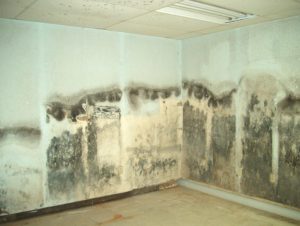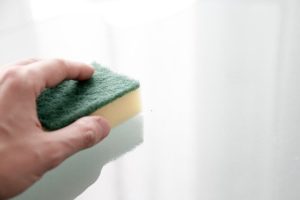Kill Mold With Vinegar

Got mold? Kill mold with vinegar. We are always on the hunt for natural, effective solutions for cleaning mold. Our favorite the household staple: Vinegar. Vinegar is a powerful mold killer. According to ServiceMaster Restoration and Cleaning, the mild acid in vinegar kills about 82% of known molds and can help prevent future outbreaks. Common places you can find mold in your home are on drywall, the foundation, the gutters, HVAC systems, and the roof.
While you can remove small amounts of mold using vinegar, it is best to hire professionals when necessary or when dealing with toxic black mold known as cladosporium. Besides a crisis, such as a flooded home, the Environmental Protection Agency (EPA) advises hiring professionals when the area mold covers is about 10 square feet or more.
HOW DOES VINEGAR KILL MOLD?
Vinegar possesses natural antifungal and antibacterial properties. The acetic acid that is present in vinegar has a decently strong pH of 2.5 enabling it to disrupt and stop the growth of mold, fungi, and other organisms. This artificial chemical free cleaning alternative means that during this process, no chemical resistant microbes are created which is often the case when using bleach.
IS VINEGAR MORE EFFECTIVE THAN BLEACH?
Vinegar is a better choice than bleach for killing mold, for a variety of reasons. The most important reason is that the application of bleach will most likely leave behind spores that have grown to a high level, allowing them to multiply without competition. The EPA doesn’t recommend bleaching mold to kill or remove it. The application of bleach will most likely leave behind spores that have grown to a high level.
ServiceMaster states:
“..bleach only kills the surface mold and not the membrane beneath. This means that the mold will come back. The mold membranes will actually grow deeper into porous surfaces such as wood or drywall if bleach is applied to them.”
WHAT TYPE OF VINEGAR SHOULD YOU USE TO CLEAN MOLD?
First, keep the apple cider vinegar aside for salad dressing. Regular white distilled vinegar is usually sold at five percent acidity to clean mold. You can also use “cleaning vinegar”, which typically has six percent acidity. Both can effectively kill mold and are regularly sold at a variety of grocery and big box stores. Additionally, generic or store brands can be as effective as the commonly reached for name brand vinegars
HOW LONG DOES VINEGAR TAKE TO KILL MOLD?
For maximum effectiveness, you can leave the vinegar on the mold for 60 minutes. This allows ample time for the vinegar to saturate any present mold. Then, wipe or scrub the mold with paper towel or a disposable sponge, specially designed to trap microbes. Using a regular rag or sponge risks the spread of mold spores throughout your home.
For follow-up treatments where mold is present use the same technique once a week. For preventative methods you can do a vinegar treatment on mold prone areas once every 2-4 weeks.
Like with any cleaning product, we recommend that you wear gloves as the acidity of vinegar can cause skin irritation. When cleaning up any mold you must use goggles, and a mask to protect your skin and airways from mold. Vinegar’s acidity can cause damage to some surfaces. We do not recommend vinegar being used on natural stone, waxed timber, cast iron, or aluminum.
This is where Homebiotic Probiotic Spray comes in! It is the perfect end to your natural cleaning routine, replenishing the population of beneficial microbes keeping your home cleaner, longer. Keeping a healthy balance of microbes in your home ensures your home microbiome stays healthy and keeps all microbe populations in check.










 WHAT DOES CLADOSPORIUM MOLD LOOK LIKE?
WHAT DOES CLADOSPORIUM MOLD LOOK LIKE? WHERE IS CLADOSPORIUM FOUND?
WHERE IS CLADOSPORIUM FOUND?